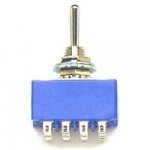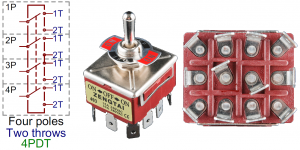Hiya, I purchased a switch that permits one amp to drive two pairs of speakers, the speaker pair being selected from a rocker switch with three positions:
A
A+B (to drive both speaker pairs at the same time)
B
However, I intended to use this as a switch that allows me to drive one pair of speakers but selecting which amp I use, as I have a T Amp for everyday radio listening and an OTL for more "serious" listening.
The vendor (ebay) told me it would work fine in reverse but of course there's crosstalk etc. Opening the item, I'll desolder the switch but can I reuse this switch to accomplish what I need? I think I need more terminals but please let me know your thoughts.
To recap, problem: Switch needed that selects either Amp A or Amp B which then drives one pair of speakers, with no bleed/crosstalk as I have a source A B selector switch and I can faintly hear Amp A when Amp B is selected etc so each path needs isolation (it sounded lousier too).
The switch box is fine (see photo) and I'll re-use the terminal strip etc, will desolder rocker switch as necessary however.
Thanks all.
A
A+B (to drive both speaker pairs at the same time)
B
However, I intended to use this as a switch that allows me to drive one pair of speakers but selecting which amp I use, as I have a T Amp for everyday radio listening and an OTL for more "serious" listening.
The vendor (ebay) told me it would work fine in reverse but of course there's crosstalk etc. Opening the item, I'll desolder the switch but can I reuse this switch to accomplish what I need? I think I need more terminals but please let me know your thoughts.
To recap, problem: Switch needed that selects either Amp A or Amp B which then drives one pair of speakers, with no bleed/crosstalk as I have a source A B selector switch and I can faintly hear Amp A when Amp B is selected etc so each path needs isolation (it sounded lousier too).
The switch box is fine (see photo) and I'll re-use the terminal strip etc, will desolder rocker switch as necessary however.
Thanks all.
Attachments
If you use the middle terminals of the switch to feed the speaker then each amp can sit on the respective outer terminals.
This will possibly only work on one polarity due to the type of amplifiers used.
Working in reverse, there should be no cross talk as the channels are independent. If you have cross talk, there is a grounding/common issue. Why not use a four pole two way change over switch, you can switch correctly then without grounding issues.
This will possibly only work on one polarity due to the type of amplifiers used.
Working in reverse, there should be no cross talk as the channels are independent. If you have cross talk, there is a grounding/common issue. Why not use a four pole two way change over switch, you can switch correctly then without grounding issues.
In the A+B position the switch will connect the output of both amps together, when used in reverse. This is equivalent to shorting both outputs, so may not be good for amp health.
Thanks folks, I see.
I would need a switch with at least 4 terminals then, as volunteered. But how would I wire it?
How many positions does this (pic: 4 pole 2 way) switch have, 2 right? So as I look at the picture a "pair" is the front and back pair or the "left and right" pair as viewed?
What's tripping me up is that each amp will have 4 wires, and then there's the speaker wires.
Thanks (pic attached).
I would need a switch with at least 4 terminals then, as volunteered. But how would I wire it?
How many positions does this (pic: 4 pole 2 way) switch have, 2 right? So as I look at the picture a "pair" is the front and back pair or the "left and right" pair as viewed?
What's tripping me up is that each amp will have 4 wires, and then there's the speaker wires.
Thanks (pic attached).
Attachments
Last edited:
A 4-pole 2-way switch normally has 2 positions (a few may have an extra centre position - but you don't want that). It has 12 tags. You have 12 wires. To find which goes where, either see the switch datasheet or use a continuity checker.
- Status
- Not open for further replies.


